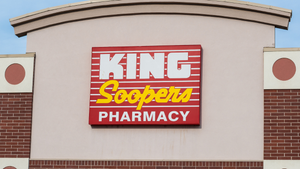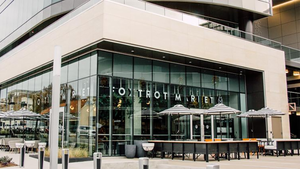The Fresh Imperative: Focus on Product, TechnologyThe Fresh Imperative: Focus on Product, Technology
Fresh foods contribute about a third of total store sales, so retailers need to focus on and invest in department designs that attract shoppers, while motivating them to buy. Technological advances, such as new case doors and LED lights are a key, while the retailers should be looking ahead to energy control systems, and incorporating what they learn by redesigning fresh into Center Store. Full article brought to you by Hillphoenix.
November 4, 2013
Dan Alaimo
Customers want simple designs for fresh food departments that work to emphasize product, not extraneous fluff, said Terry Roberts, president, Merchandising By Design, Carollton, Texas.
Taking this into account is especially critical considering fresh foods’ 29% contribution to total store sales, according to Nielsen Perishables Group FreshFacts 2012, which pegs meat at a 39% contribution and produce at 32%. Best practices to achieve this include practical equipment, such as large French doors for all fresh and frozen coolers, LED lighting to improve visual appeal and efficiency, and an integration of in-store merchandising and online ordering. Looking ahead, there is an extension of these practices into other parts of the retail environment, such as Center Store, and adoption of new technologies that control lighting, energy and even customer flow, which is of particular benefit at the checkouts.
When it comes to fresh departments like produce, meat, seafood, cheese and dairy, “what customers tell us is, spend money on what is important,” Roberts said. “Activate the space, forget the frills, make the right investment.” The right investments are better merchandising displays, more fresh product displays, and technology. “That’s not just for the millennials, but also for the boomers, whether it is providing an in-store experience where the store recognizes them through technology, or enabling them to use their smart phones to check pricing,” she said.
“As we move into this art and science of compelling fresh formats, the key to this is, we are at a crossroads of how retailers approach expansion and development. We have to re-imagine the stores, and move into much more responsive and creative environments. Retailers should have staff that is prepared for the new technologies. We aren’t moving as quickly as we should into how the stores cope with online retailing. We need to look at alternative formats.” This includes formats where fresh is the focus in the front of the store, while a warehouse for online order fulfillment is in the back for staple items, “so the customer doesn’t have to select these products in long aisles,” Roberts said.
To accentuate the visual merchandising of fresh foods in cleanly designed environments, “you move into the very sleek doors, and the advancements we have made in refrigeration, where we have clear view doors, big 5-foot French door openings, and superior LED lighting, which gives us fantastic visuals on the refrigerated fresh foods,” she said.
Through the Glass Door
Some newer stores, such as those operated by H-E-B Central Market in Austin and Whole Foods in Dallas, have over 400 doors for their various cold cases. “Everything is behind doors. It is not just frozen and dairy. It’s all the way through packaged produce, and seafood, and packaged meats. It’s a much different presentation than just having frozen and dairy behind doors.” Despite what would appear to be an obstacle, shoppers see the benefit of doors in keeping the product fresh, providing a superior presentation, saving the store energy, and they like them, Roberts said. “Customers know refrigeration works better with doors,” she noted.
For the retailer, the doors provide better visibility and big savings on energy costs, she said.
In conjunction with doors, LED lighting helps optimize the presentation of fresh foods, while also saving energy. “It is far superior lighting because we can match the Calvin color rendering to the specific products, and the candela, or the beam spread of the lighting, is designed specifically to spread across the front of shelving in 5-foot openings. The old fluorescent lighting is a big blob of light and it is not directed by any type of optics to give us the nice smooth lighting across the front of the products,” Roberts said.
To get the full benefit of LED, retailers need to use it for accent and case lighting, as well as the ambient lighting of the store. “We can get specific color rendering, we can get specific direction of the lighting, and do a full lighting plan that combines the case lighting with the accent lighting to light the fresh foods in the most appropriate lighting for the products,” she said.
“We have to learn a new vocabulary about lighting design using LED because we have the ability to be very accurate on color rendering and very accurate on beam direction and where we are putting the lighting.”
But, she noted, cold case doors and LED lighting are no longer emerging technologies as they have arrived. “They are very well developed and suitable for our stores now.”
Optimizing Energy Use
The next in-store technology to emerge will be energy management systems. To build these optimizing systems — she terms them BOS, for business optimizing systems — “we are going to need control systems, and systems that manage more than just refrigeration. They manage lighting, because we have the ability with lighting designs now to change the color rendering throughout the day, or change the color rendering throughout the season. We put in lighting where we can change the intensity and where we can change the beam angles.”
The control systems can also track customer flow so store managers know when more cashiers are needed at the front checkouts. These systems can also be used for price optimization and electronic shelf labeling.
Design concepts learned in fresh departments can also be applied to Center Store, which retailers have long been struggling to reinvigorate.
The goal is “to create more destination and impactful departments, and compartmentalization within the center of the store, rather than just the straight runs and “cans-of-peas” types of merchandising, so it is much more interesting to the shopper, and similar to the way that we are doing fresh merchandising.” New flexible shelving units are being developed where art and science converge. “They can morph between straight runs into curves, and into angles. They can morph in size and shape, so we can change the configurations of our Center Store more easily than we have been able to, and more fluidly like we do in our fresh departments,” Roberts said.
The designers are trying to make the entire store operate more like the department store of food, using compartmentalization, departmentalization, and focus areas “to direct the customer around the shopping trip, rather than it just being straight runs.”
As stores are downsized to meet the needs of cities and rural areas, the main part of the store will be dedicated to fresh merchandising presentations, while the back will be a staging area for staple products that have been ordered in advance online by the shopper. “The prices will be cheaper and it takes the retailer out of those commodity items to allow them to focus on what customers like to shop for and pick by hand, and that is the fresh foods,” Roberts said.
She sums up her concept: “It is rethinking the retail format into the next generation, and the next style of retail stores.”
You May Also Like




